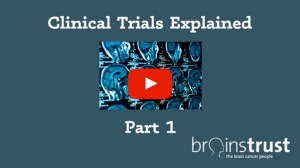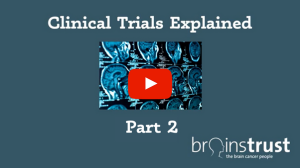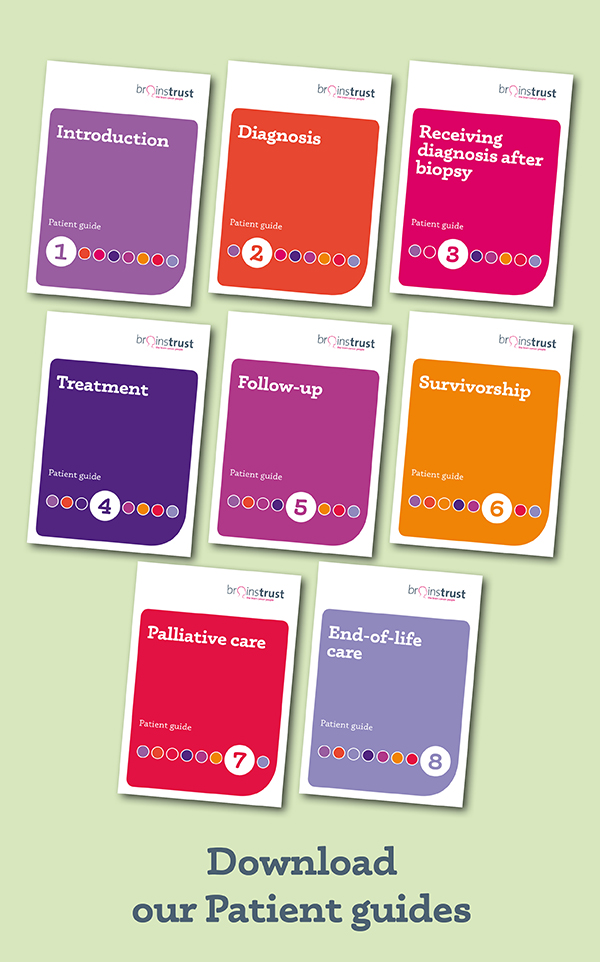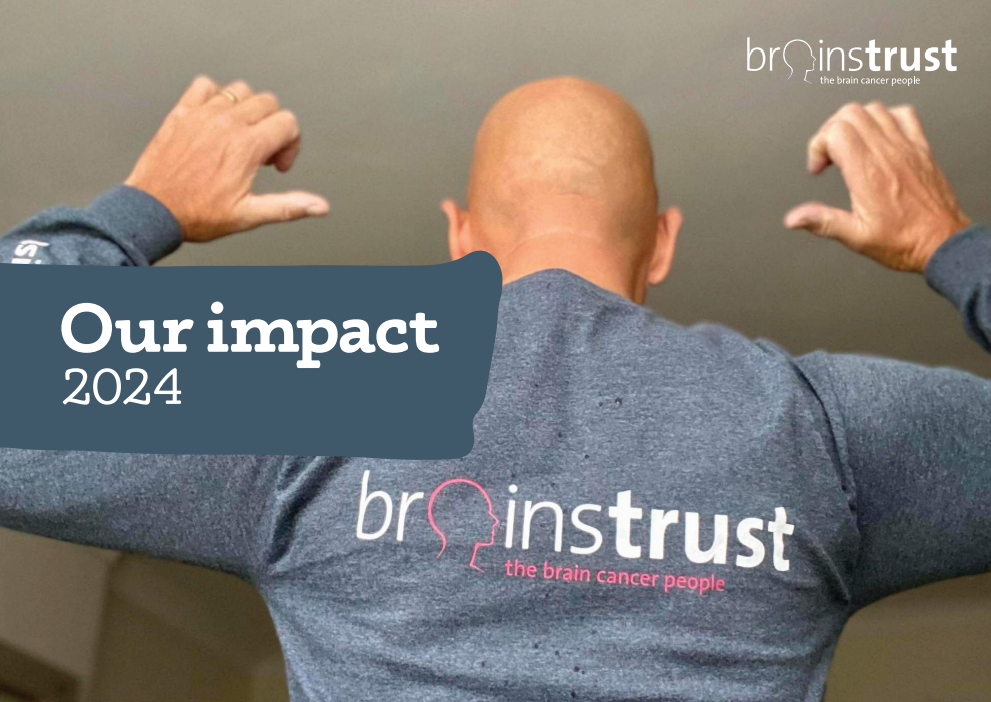Brain tumour clinical trials
Below, find information on what brain tumour clinical trials are, how they are designed to run, how you might join a trial and what some of the benefits and risks might be.
What is a clinical trial?
A clinical trial is a research study, which involves people. People test treatments for an illness or approaches to prevention or diagnosis. This tells us whether the new approaches are safe and effective. A typical trial might research:
- Whether a new drug is as effective as an existing one
- Whether a combination of treatments (e.g. radiotherapy and chemotherapy) work better if used at the same time
- Whether giving a drug in a different way can be more effective.
Cancer clinical trials will research drugs, screening, diagnosis, treatments and controlling symptoms.
We need clinical trials so that we can continue to develop better healthcare. They provide evidence so that doctors know which treatments work best.
Follow brainstrust’s clinical trials video series which covers all the basics of clinical trials.
Find brain tumour support on your doorstep, and current brain tumour trials at www.braintumourhub.org.uk
How do they work?
Clinical trials are designed by specialists with input from a wide range of people, which can include patients. A lot of work has to be done before a trial can start; this is the design phase. During this phase it is decided what questions need to be answered by the trial and the results of previous trials are studied (this is called a systematic review). The outcome of this phase will be a design and this forms the trial protocol.
The trial protocol will include guidelines about who can take part. These are called eligibility criteria. This makes sure that the sort of people who may benefit from the trial are included and that people are not being exposed to avoidable risks.
The trial protocol is then sent to an ethics committee. This is an independent group of people who will decide whether the trial should go ahead. They will discuss the potential benefits, whether the information is clear, whether the way in which people are asked to participate in the trial is appropriate.
Once the trial protocol has permission to go ahead it happens in stages:
- Phase 1 trials look at whether a trial treatment is safe or has any harmful effects. The research team will also find out the best dose (if relevant) to use. This usually involves a small group of people.
- Phase 2 trials look at how well a treatment works. Researchers will know more about the treatment by now. This phase involves a larger group of people. Only a treatment that has got through these 2 phases goes into phase 3 testing.
- Phase 3 trials test a new treatment against the existing standard treatment. If it gives better results, it may become the new standard treatment. This phase is large and will involve more people than phase 2.
- Phase 4 trials are carried out after a treatment has been shown to work and has been licensed. In this phase researchers collect information about side effects, safety and the long term risks and benefits of a treatment.
Terms you might hear
Controlled trials: a control is a standard against which experimental observations may be evaluated. In clinical trials, one group of participants is given an experimental drug, while another group (i.e., the control group) is given either a standard treatment for the disease or a placebo.
Placebo: a placebo treatment looks like the treatment being tested, but it is inactive. By comparing people’s responses to the placebo and to the treatment being tested, researchers can tell whether the treatment is having any real benefit.
Blind trial: A blind trial is a trial where the people taking part do not know which treatment they are getting. They could be getting the new treatment. Or they could be getting standard treatment or a placebo, depending on the design of the trial.
Double-blind trial: In the double-blind trial neither the patient nor the researchers giving the treatment know who is being treated and who is in the placebo control group.
Randomised trial: this means that people are picked at random to the treatment groups in a trial. So you can get double blind, randomised trials!
Where can I find a brain tumour clinical trial?
A good starting point for finding currently recruiting and upcoming clinical trials is clinicaltrials.gov, run by the National Library of Medicine. This features both UK-based and international trials with an easy to use interface.
Visit clinicaltrials.gov
For more information on clinical trials in the UK and abroad, have a look at these websites:
 myTomorrows
myTomorrows
myTomorrows has a powerful technology that efficiently connects patients, physicians, trial sites and BioPharma, supporting straightforward and transparent access to drugs in development worldwide.
Through free of charge services, patients and their families are empowered by knowing and understanding their options to make the best possible decisions regarding their treatment pathway.
Discover and access clinical trials for you or your loved ones. Book a call with a dedicated patient navigator to find out more.
Visit myTomorrows.
Clinical Net
This is a tool built for a data research study aimed to simplify the process of finding appropriate clinical trials.
Visit the Clinical Net Trial Finder.
NIHR Be Part of Research
The NIHR UK Clinical Trials Gateway provides easy to understand information about clinical research trials running in the UK, and gives you and others access to a large range of information about these trials. Be careful though because some of the brain tumour trials listed are more generic; they are trials based on the broader picture and are not brain tumour specific.
Cancer Research UK
This is the Cancer Research UK site. It provides information about closed, as well as open trials, and past trial results:
Visit the Cancer Research clinical trials page
ClinicalTrials.eu

ClinicalTrials.eu mission is to empower patients by providing trusted , accessible, and easily understood information about clinical trials. It aims to break down the barriers that prevent patients from accessing vital research opportunities while fostering collaboration between patients, research centres, and sponsors. By building a platform that is patient-centric and innovative, ClinicalTrials.eu is redefining the way clinical trials are discovered and accessed across Europe.
Visit ClinicalTrials.eu
Virtualtrials.com
A US site, specifically focused on brain cancer:
Visit www.virtualtrials.com
Health Talk Online
Health Talk Online is a patient centred website. Whilst generic, it has some good background information about clinical trials which is easily accessible:
Brain tumour support is driven by your support. We know. Click here to help us do even more for people living with a brain tumour in your area.
What should I think about before participating in a trial?
You need to know as much as possible about the clinical trial and feel comfortable asking questions about it, the care expected while in a trial, and the cost of the trial. The following questions might be helpful for you to discuss with your doctor.
- What is the purpose of the trial?
- Who is going to be in the trial?
- Why do researchers believe the experimental treatment being tested may be effective? Has it been tested before?
- What kinds of tests and experimental treatments are involved?
- How do the possible risks, side effects, and benefits in the study compare with my current treatment?
- How might this trial affect my daily life?
- Will taking part in a clinical trial stop me from receiving any other treatment that might be recommended by my healthcare team?
- How long will the trial last?
- Will I need to stay in hospital?
- Who will pay for the experimental treatment?
- Will I be reimbursed for other expenses?
- What type of long-term follow up care is part of this study?
- How will I know that the experimental treatment is working? Will results of the trials be provided to me?
- Who will be in charge of my care?
What are the benefits and risks of participating in a clinical trial?
Benefits
Brain tumour clinical trials that are well-designed and well-executed are the best approach for you to:
- Play an active role in your own health care.
- Gain access to new research treatments before they are widely available.
- Obtain expert medical care at leading health care facilities during the trial.
- Help others by contributing to medical research.
Risks
There are risks to clinical trials:
- There may be unpleasant, serious or even life-threatening side effects.
- The experimental treatment may not be effective.
- More of your time and attention might be needed than an existing standard treatment, such as trips to the research centre, more treatments, hospital stays or complex dosage requirements.
This information has been sourced and adapted from Understanding Clinical Trials, version 2, October 2010, published by the National Institute for Health Research. The source material is available to download as a pdf at: http://www.crncc.nihr.ac.uk/
Did this information make you feel more resourced, more confident or more in control?
Date published: 17-05-2009
Last edited: 01-2025
Due for review: 01-2028













